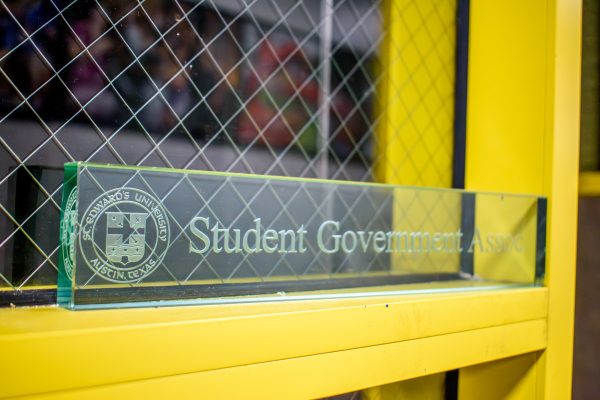Congress debates student loan takeover
The majority of St. Edward’s University students finance their education with Federal Family Education Program loans, but thanks to pending Federal legislation, that soon may no longer be an option.
The Student Aid and Fiscal Responsibility, passed by the U.S. House of Representatives, would end the Federal Family Education Loan Program, from which most St. Edward’s students borrow loans. Students would have to borrow directly from the government instead. In addition, students would have to fill out a new promissory note, and when they graduate, their loans might be split between more than one holder.
One major goal of the bill is to save the government an estimated $87 billion given out in subsidies to banks each year paid on student loans. But questions of whether putting the government in control of student loans would be better for students.
The Direct Loan program offers students Direct Stafford loans and Direct Plus loans directly from the Department of Education rather than a subsidized loan through a private lender.
Loans that are subsidized have the interest rates paid by the Federal Government during a student’s time in school. Unsubsidized loans require that students either pay the interest while in school or defer payments on the interest until graduation. Under the bill, the government will still offer subsidized and unsubsidized loans.
The Federal Family Education Loan program consists of both subsidized and unsubsidized Stafford loans and plus loans. Stafford and Plus loans will not be offered after June 30.
“Both loan programs use the same basis for what the interest is going to be, they have to follow the same regulations for what fees can be charged, and what payment terms are offered,” said Steven Peterson, assistant director of Student Financial Services.
Over 55 percent of St. Edward’s students have loans with the Federal Family Education Loan Program, according to Doris Constantine, director of Student Financial Services.
The bill will not affect any loans students currently have with the Federal Family Education Loan Program, according to Peterson. Students who previously have taken out loans through the Family Federal Education Loan Program loans will have to fill out a new promissory note.
“If the federal government does mandate the switch and completely stops the Federal Family Education Loan program, all returning students will be awarded the federal direct,” said Constantine. “We will have to get from them a new promissory note that they do electronically on the web.”
Interest rates will not necessarily increase nor decrease under the Direct Loan Program because interest rates for the loans are federally mandated.
“[The interest rates] are the exact same on both the direct and the Federal Family Education Loan Program with the sole exception of one particular loan called the Federal Direct Parent Plus Loan,” Peterson said. “And this is a loan for parents and not for student borrowers.”
The bill would also make significant changes to the Perkins Loan program.
The Perkins loan is currently a subsidized loan, but under this proposed bill, Perkins loans would become unsubsidized, interest-accruing loans while students are still in school.
The Student Aid and Fiscal Responsibility Act intends to use the savings from switching to the direct loan program to increase Pell grants.
“I don’t think it’s necessarily [going to be given to] more students,” Constantine said. “It would just be that each individual student’s Pell grant might rise slightly.”
Preparation
The university is prepared for this transition even though the bill would place the deadline for ending the Federal Family Education Loan Program this coming June, Constantine said.
“We have given ourselves adequate time and thought and investigation,” Constantine said, “We did not want to be in a position of ‘what do you do?’ at the last minute.”
The university started its own pilot program for the direct loan program after lenders began having financial problems and start getting out of the Federal Family Education Loan Program several years ago, according to Constantine.
The pilot program offered loans through the Direct Loan Program to new borrowers and transfer students who already had loans through this program.
Even if the bill does not pass, Constantine said that the university plans to offer new borrowers loans through the Direct Loans Program anyway.
“Because there are so many thousands of borrowers and it is such a complicated system, we knew we had to transition into the direct loan program,” Constantine said.
Constantine said the university is prepared for this transition even though the bill would place the deadline for ending the Federal Family Education Loan Program this coming June.
Students React
Students, who, as a group, are most affected by the change, have mixed reactions to the bill.
“I am against it because the government is involved in to much of this stuff,” sophomore Megan Pardy said. “We are losing control of were our money goes.”
Sophomore Andrew Harvey fears that the government’s takeover may harm students.
“If the Stafford loans dry up, that affects more than half of the St. Edward’s students,” Harvey said. “If that happens we are gone. We are back to the community colleges in our hometowns.”
But Harvey said that he’s no necessarily opposed to the government running the program.
“The idea having to pay back two different entities is what I am opposed to,” Harvey said.
Senior Sarah Broll said that Congress is focusing on the wrong issue. She said she wants Congress to fix the job market instead of complicating the loan system.
“If they want to make sure students can reimburse them for the loans than they need to make more jobs available,” Broll said.
The House Vote
The house voted 253 to 171 in favor of the bill. Three Austin-area Congressmen represent districts that cover the University of Texas at Austin, St. Edward’s University, Huston-Tillotson University, Austin Community College and Concordia University. Two of the Congressmen voted against the bill and one voted for it.
U.S. Rep. Michael McCaul R-Texas, who represents part of UT and whose district stretches from Austin to Houston, said that he always supported expanding the availability of college aid, but voted against this specific bill.
“By giving the federal government a monopoly over student lending, this plan will eliminate choice, competition, and innovation in our student loan system,” McCaul said, “Moreover, in an environment where job security is already a concern, this bill will lead to job loss for those involved with the Federal Family Education Loan program.”
U.S. Rep. Lamar Smith R-TX said that he voted against this bill because it replaces the respected Federal Family Education Loan Program with a government run system of lending.
“A government-run lending program would be bad for students, bad for schools, and bad for jobs,” Smith said, “It would provide the bare minimum in services to students and families while adding layers of costly bureaucracy and mountains of additional paperwork.”
U.S. Rep. Lloyd Doggett D-Texas, who voted for this bill and whose district St. Edward’s lies in, said that students from Huston-Tillotson University, the University of Texas, Texas State University, Austin Community College, and St. Edwards University will receive around $83.1 million dollars in Pell Grants over the next decade thanks to the bill.
“By eliminating the unnecessary middle-man role of private financial institutions, cutting red tape, and lending directly to students, the federal government will have more money for our students and more resources left over to apply to reduce the national debt,” Doggett said.
The bill has not yet been voted on by the U.S. Senate. Both the House and the Senate will have to pass the bill in exactly the same form before passing it on to President Obama to sign or veto.
History
The Student Aid and Fiscal Responsibility Act follows the Ensuring Continued Loans Act of 2008 that allowed the U.S. Department of Education to purchase Stafford and Plus loans this past summer.
The government began purchasing loans after the financial crisis decreased funding for student loans. Sallie Mae, the nation’s largest provider of student loans, cut back on lending last year in response to the financial crisis.
Under both bills, students may have to pay more than one loan holder once the repayment period begins.
If a student currently has a Federal Family Education Loan Program loan, they are not disadvantaged in any way if they do not switch over to the Direct Loan Program.
“If a student has a Federal Family Education Loan Program loan, it’s not like they are missing out on a party,” Peterson said.





